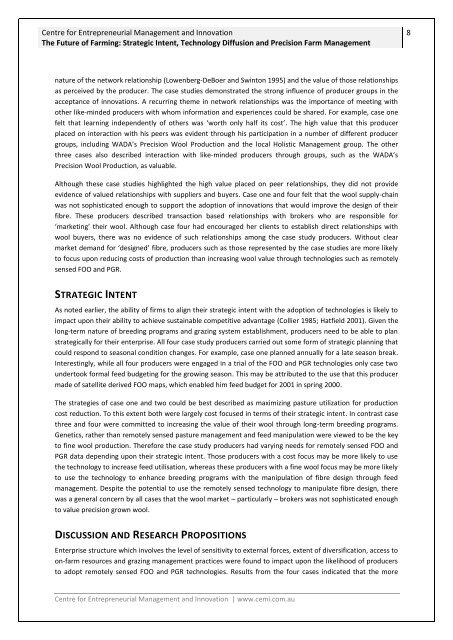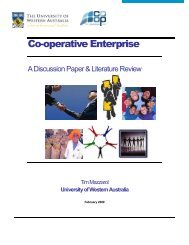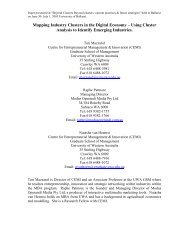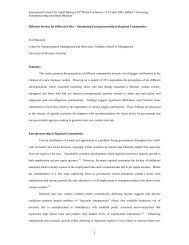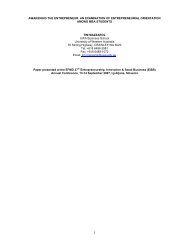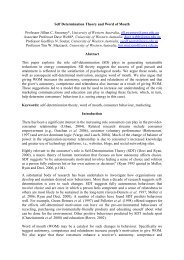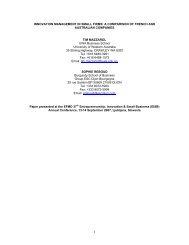The Future of Farming: Strategic Intent, Technology Diffusion ... - CEMI
The Future of Farming: Strategic Intent, Technology Diffusion ... - CEMI
The Future of Farming: Strategic Intent, Technology Diffusion ... - CEMI
You also want an ePaper? Increase the reach of your titles
YUMPU automatically turns print PDFs into web optimized ePapers that Google loves.
Centre for Entrepreneurial Management and Innovation<strong>The</strong> <strong>Future</strong> <strong>of</strong> <strong>Farming</strong>: <strong>Strategic</strong> <strong>Intent</strong>, <strong>Technology</strong> <strong>Diffusion</strong> and Precision Farm Management8nature <strong>of</strong> the network relationship (Lowenberg-DeBoer and Swinton 1995) and the value <strong>of</strong> those relationshipsas perceived by the producer. <strong>The</strong> case studies demonstrated the strong influence <strong>of</strong> producer groups in theacceptance <strong>of</strong> innovations. A recurring theme in network relationships was the importance <strong>of</strong> meeting withother like-minded producers with whom information and experiences could be shared. For example, case onefelt that learning independently <strong>of</strong> others was ‘worth only half its cost’. <strong>The</strong> high value that this producerplaced on interaction with his peers was evident through his participation in a number <strong>of</strong> different producergroups, including WADA’s Precision Wool Production and the local Holistic Management group. <strong>The</strong> otherthree cases also described interaction with like-minded producers through groups, such as the WADA’sPrecision Wool Production, as valuable.Although these case studies highlighted the high value placed on peer relationships, they did not provideevidence <strong>of</strong> valued relationships with suppliers and buyers. Case one and four felt that the wool supply-chainwas not sophisticated enough to support the adoption <strong>of</strong> innovations that would improve the design <strong>of</strong> theirfibre. <strong>The</strong>se producers described transaction based relationships with brokers who are responsible for‘marketing’ their wool. Although case four had encouraged her clients to establish direct relationships withwool buyers, there was no evidence <strong>of</strong> such relationships among the case study producers. Without clearmarket demand for ‘designed’ fibre, producers such as those represented by the case studies are more likelyto focus upon reducing costs <strong>of</strong> production than increasing wool value through technologies such as remotelysensed FOO and PGR.STRATEGIC INTENTAs noted earlier, the ability <strong>of</strong> firms to align their strategic intent with the adoption <strong>of</strong> technologies is likely toimpact upon their ability to achieve sustainable competitive advantage (Collier 1985; Hatfield 2001). Given thelong-term nature <strong>of</strong> breeding programs and grazing system establishment, producers need to be able to planstrategically for their enterprise. All four case study producers carried out some form <strong>of</strong> strategic planning thatcould respond to seasonal condition changes. For example, case one planned annually for a late season break.Interestingly, while all four producers were engaged in a trial <strong>of</strong> the FOO and PGR technologies only case twoundertook formal feed budgeting for the growing season. This may be attributed to the use that this producermade <strong>of</strong> satellite derived FOO maps, which enabled him feed budget for 2001 in spring 2000.<strong>The</strong> strategies <strong>of</strong> case one and two could be best described as maximizing pasture utilization for productioncost reduction. To this extent both were largely cost focused in terms <strong>of</strong> their strategic intent. In contrast casethree and four were committed to increasing the value <strong>of</strong> their wool through long-term breeding programs.Genetics, rather than remotely sensed pasture management and feed manipulation were viewed to be the keyto fine wool production. <strong>The</strong>refore the case study producers had varying needs for remotely sensed FOO andPGR data depending upon their strategic intent. Those producers with a cost focus may be more likely to usethe technology to increase feed utilisation, whereas these producers with a fine wool focus may be more likelyto use the technology to enhance breeding programs with the manipulation <strong>of</strong> fibre design through feedmanagement. Despite the potential to use the remotely sensed technology to manipulate fibre design, therewas a general concern by all cases that the wool market – particularly – brokers was not sophisticated enoughto value precision grown wool.DISCUSSION AND RESEARCH PROPOSITIONSEnterprise structure which involves the level <strong>of</strong> sensitivity to external forces, extent <strong>of</strong> diversification, access toon-farm resources and grazing management practices were found to impact upon the likelihood <strong>of</strong> producersto adopt remotely sensed FOO and PGR technologies. Results from the four cases indicated that the moreCentre for Entrepreneurial Management and Innovation | www.cemi.com.au


